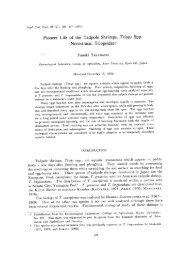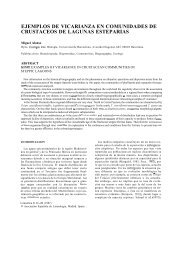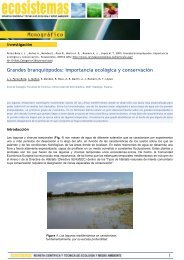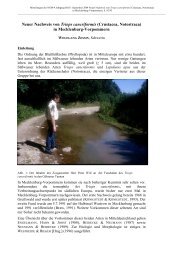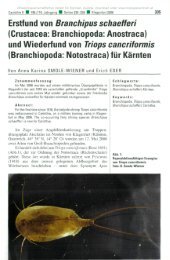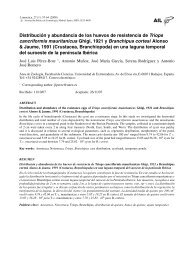Reproductive isolation and genetic differentiation in North American ...
Reproductive isolation and genetic differentiation in North American ...
Reproductive isolation and genetic differentiation in North American ...
Create successful ePaper yourself
Turn your PDF publications into a flip-book with our unique Google optimized e-Paper software.
136<br />
lations. For legless body r<strong>in</strong>gs, only Fords Dry Lake<br />
differed from other populations (Shallow Water <strong>and</strong><br />
Hurricane); no other pairwise comparsions were significant.<br />
Similarly, for carapace ratio, only the Coyote Dry<br />
Lake site was different (from Indian Trail <strong>and</strong> Valerie<br />
Jean). There were no significant differences between<br />
any populations for telson sp<strong>in</strong>ation. The variation <strong>in</strong><br />
total body r<strong>in</strong>gs was more complex. Individuals from<br />
Valerie Jean differed from most other populations, <strong>and</strong><br />
Fords Dry Lake <strong>and</strong> Coyote Dry Lake differed from<br />
Lordsburg, Shallow Water <strong>and</strong> Hurricane. In general,<br />
populations that tend to be most different are those that<br />
lack males, but there is no cluster<strong>in</strong>g of populations <strong>in</strong>to<br />
<strong>and</strong>rodiecious <strong>and</strong> unisexual groups.<br />
In T. longicaudatus, sample sizes were sufficient to<br />
allow comparisons among populations for both males<br />
<strong>and</strong> females. S<strong>in</strong>ce males are not present <strong>in</strong> all populations,<br />
these comparisons were conducted <strong>in</strong>dependently.<br />
In females, variation <strong>in</strong> carapace ratio is generally<br />
limited. Two populations, Santa Rosa <strong>and</strong> Dalhart,<br />
have relatively short carapaces <strong>and</strong> these are significantly<br />
different from some, but not all, of the other<br />
populations. For telson sp<strong>in</strong>ation, non-parametric tests<br />
<strong>in</strong>dicated no significant pairwise differences. The r<strong>in</strong>g<br />
characters, however, showed strong correlations with<br />
reproductive type; all of the significant pairwise differences<br />
were between bisexual <strong>and</strong> unisexual populations.<br />
In male T. longicaudatus, <strong>in</strong>dividual populations<br />
differed from each other, but with no consistent pattern<br />
across characters. Specifically, no population pairs<br />
differed for telson sp<strong>in</strong>ation, Liberal differed only from<br />
Dalhart for legless r<strong>in</strong>gs, <strong>and</strong> only from Santa Rosa for<br />
total r<strong>in</strong>gs, whereas both Liberal <strong>and</strong> White Woman<br />
differed from Santa Rosa on carapace ratio, but not<br />
from each other.<br />
With respect to the morphological characters we<br />
exam<strong>in</strong>ed, females of T. newberryi are relatively homogeneous,<br />
irrespective of their geographical orig<strong>in</strong> <strong>and</strong><br />
whether or not they are from sexual populations. Triops<br />
longicaudatus females are more variable, but the<br />
pr<strong>in</strong>cipal variation arises from meristic <strong>differentiation</strong><br />
between bisexual <strong>and</strong> unisexual populations. The<br />
population-level analysis supports the pattern obta<strong>in</strong>ed<br />
when data are aggregated over populations. The two<br />
modes <strong>in</strong> the frequency distributions of meristic characters<br />
<strong>in</strong> T. longicaudatus (Figure 4) are created by the<br />
discont<strong>in</strong>uity <strong>in</strong> character states of bisexual <strong>and</strong> unisexual<br />
populations. Males, although <strong>in</strong>frequent <strong>in</strong> T.<br />
newberryi, <strong>and</strong> not particularly variable <strong>in</strong> T. longicaudatus,<br />
nevertheless differ from females. The morphological<br />
data thus def<strong>in</strong>es five entities, unisexual <strong>and</strong><br />
bisexual females of T. longicaudatus, females of T.<br />
newberryi, <strong>and</strong> males of each species. We have pooled<br />
all of our morphological data <strong>in</strong>to these categories,<br />
<strong>in</strong>clud<strong>in</strong>g <strong>in</strong>formation on additional character states<br />
not rout<strong>in</strong>ely measured on all <strong>in</strong>dividuals (see Methods).<br />
Statistics for the seven characters are summarized<br />
<strong>in</strong> Table 5.<br />
Several aspects of these additional characters are<br />
worth not<strong>in</strong>g. First, the number of abdom<strong>in</strong>al body<br />
r<strong>in</strong>gs with legs is relatively constant among all the<br />
groups of <strong>North</strong> <strong>American</strong> Triops, vary<strong>in</strong>g only from<br />
18.3 to 19.9 (Table 5). S<strong>in</strong>ce the number of thoracic<br />
r<strong>in</strong>gs is fixed at 11 (we found no exceptions), the variation<br />
<strong>in</strong> total body r<strong>in</strong>gs is highly correlated with the<br />
number of legless abdom<strong>in</strong>al r<strong>in</strong>gs. Second, the number<br />
of r<strong>in</strong>gs covered by the carapace is relatively constant,<br />
vary<strong>in</strong>g from 10.3 to 13.2 (Table 5). In general,<br />
the carapace extends dorsally to cover the 11 thoracic<br />
r<strong>in</strong>gs. However, <strong>in</strong> unisexual T. longicaudatus, <strong>and</strong>to<br />
a lesser extent <strong>in</strong> T. newberryi females, the carapace<br />
extends farther back. Perhaps this posterior extension<br />
of the carapace, which might impede successful sperm<br />
transfer dur<strong>in</strong>g mat<strong>in</strong>g, is related to the change from<br />
outcross<strong>in</strong>g to self<strong>in</strong>g <strong>in</strong> these forms. Third, the meristic<br />
character show<strong>in</strong>g the largest variation among forms<br />
is the number of r<strong>in</strong>gs extend<strong>in</strong>g beyond the carapace<br />
(Table 5). S<strong>in</strong>ce it varies far more than the number of<br />
covered r<strong>in</strong>gs, this character is correlated (<strong>in</strong>versely)<br />
with the carapace ratio.<br />
Both species are sexually dimorphic for most of the<br />
characters we exam<strong>in</strong>ed. Males typically have more<br />
body r<strong>in</strong>gs, more legless abdom<strong>in</strong>al r<strong>in</strong>gs, fewer body<br />
r<strong>in</strong>gs covered by the carapace, <strong>and</strong> a carapace that<br />
is shorter <strong>in</strong> relation to body length (Table 5). In<br />
gonochoric populations of T. longicaudatus,thereisa<br />
marked sexual dimorphism associated with the armature<br />
at the base of the caudal furci. In males, the sp<strong>in</strong>es<br />
are much broader, <strong>and</strong> often flattened <strong>in</strong>to scale-like<br />
structures, <strong>and</strong> the proximal part of the furca is often<br />
noticeably swollen. Gurney (1924) first described this<br />
dimorphism <strong>in</strong> T. granarius. In the <strong>and</strong>rodioecious<br />
populations of both species this dimorphism is lack<strong>in</strong>g;<br />
the shape of the furca <strong>and</strong> the nature of its sp<strong>in</strong>ation<br />
does not differ perceptibly between males <strong>and</strong> females.<br />
Geographical patterns of distribution<br />
The geographical distribution of the two species, with<br />
populations of T. longicaudatus further differentiated<br />
by reproductive mode, is illustrated <strong>in</strong> Figure 1. All



